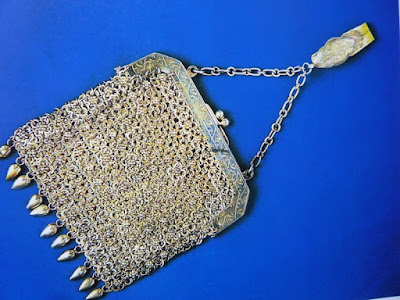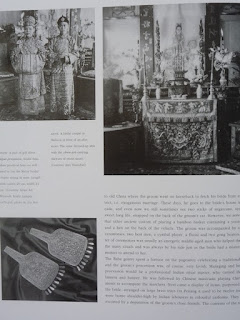Religion
Baba Nyonya subscribed to Chinese beliefs: Taoism, Confucianism and Chinese Buddhism, celebrated the Lunar New Year and the Lantern Festival, while adopting the customs of the land they settled in, as well as those of their colonial rulers.
There are traces of Portuguese, Dutch, British, Malay and Indonesian influences in Baba culture.
A certain number of Baba Nonya families were and still are, Catholic. However in this modern society, lots of young Peranakan community have been embracing Christianity.
Most notably in Indonesia, Country with the most significant Peranakan where most of the Chinese are Christians.
Clothing
The Peranakan retained most of their ethnic and religious origins (such as ancestor worship), but assimilated the language and culture of the Malays.
The Nyonya's clothing, Baju Panjang (Long Dress) was adapted from the native Malay's Baju Kurung.
It is worn with a batik sarong (batik wrap-around skirt) and 3 kerosang (brooches).
Beaded slippers called Kasot Manek were a hand-made with much skill and patience: strung, beaded and sewn onto canvas with tiny faceted glass beads from Bohemia (present-day Czech Republic).
In modern times, glass beads from Japan are preferred. Traditional kasot manek design often have European floral subjects, with colors influenced by Peranakan porcelain and batik sarongs.
They were made onto flats or bedroom slippers. But from the 1930s, modern shapes became popular and heels were added.
In Indonesia, the Peranakans develop their own kebaya, most notably kebaya encim, derived from the name encim or enci to refer to a married Chinese woman.
Kebaya encim was commonly wore by Chinese ladies in Javan coastal cities with significant Chinese settlements, such as Semarang, Lasem, Tuban, Surabaya, Pekalongan and Cirebon.
It marked differently from Javanese kebaya with its smaller and finer embroidery, lighter fabrics and more vibrant colors.
They also developed their own batik patterns, which incorporate symbols from China.
The kebaya enicm fit well with vibrant-colored kain batik pesisiran (Javan coastal batik), which incorporated symbols and motives from China; such as dragon, phoenix, peony and lotus.
For the Baba they will wear baju lokchuan (which is the Chinese men full costume) but the younger generation they will wear just the top of it which is the long sleeved silk jacket with Chinese collar or the batik shirt.
Food
From the Malay influence a unique "Nyonya" cuisine has developed using typical Malay spices. Examples are Chicken Kapitan, a dry chicken curry, and Inchi Kabin, a Nyonya version of fried chicken. \
Pindang bandeng is a common fish soup served in Indonesia during the Chinese new year and so is a white round mooncake from Tangerang which is normally used during the Autumn Festival.
Nyonya Laksa is a very popular dish in Singapore and Malaysia, as is Kueh Lapis, a type of multi layered cake, most often eaten at Chinese New Year to symbolize a ladder of prosperity.
A small number of restaurants serving Nyonya food can be found in Singapore; Penang and Malacca in Malaysia; and Jakarta, Semarang, Surabaya in Indonesia.
Marriage
It was not uncommon for early Chinese traders to take Malay women from Peninsular Malaya or Sumatra as wives or concubines
Consequently, the Baba Nyonya possessed a synergistic mix of Sino-Malay cultural traits.
Multichrome Modern Chinese-made replica enamel porcelain tea tray with a traditional Peranakan "fenghuang".
Written records from the 19th and early 20th centuries show that Peranakan men usually took brides from within the local Peranakan community. Peranakan families occasionally imported brides from China and sent their daughters to China to find husbands.
Marriages within the community and of similar stature were the norm. Wealthy men prefigured to marry a chin choay: or matrilocal marriage where husband moved in with wife's family.
Proposals of marriage were made by a gift of a pinangan, a 2-tiered lacquered basket, to the intended bride's parents brought by a go-between who speaks on behalf of the suitor.
Most Peranakans are not Muslim, and have retained the traditions of ancestor worship of the Chinese, though some converted to Christianity.
The wedding ceremony of the Peranakan is largely based on Chinese tradition, and is one of the most colorful wedding ceremonies in Malaysia and Singapore.
At weddings, the Dondang Sayang, a form of extempore rhyming song in Malay sung and danced by guests at the wedding party, was a highlight.
Someone would begin a romantic theme which was carried on by others, each taking the floor in turn, dancing in slow gyrations as they sang.
It required quick wit and repartee and often gave rise to laughter and applause when a particularly clever phrase was sung. The melodic accents of the Baba-Nonya and their particular turns of phrase lend to the charm of this performance.
Building, Furnitures
Ceramics
Entertainment
 |
| Bibi ( which involved gambling ) |
 |
| Ma Jiong |
 |
| Mini Opera |
Sponsored by
MAM Jonker88 Group,
International Cultural Exchange Foundation





















































































tq for sharing this knowledge..^^
ReplyDelete